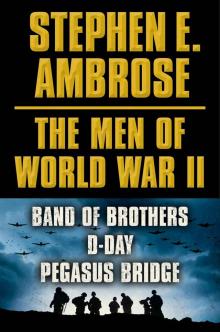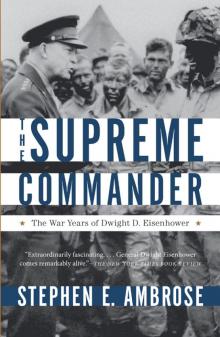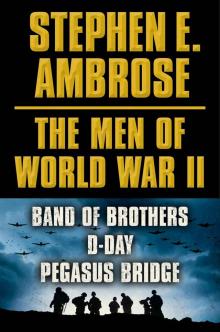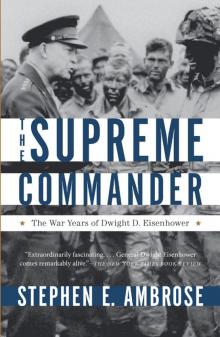- Home
- Stephen E. Ambrose
Ike's Spies Page 13
Ike's Spies Read online
Page 13
“Ah, those first OSS arrivals in London! How well I remember them,” wrote the British humorist Malcolm Muggeridge, “arriving like jeune filles en fleur straight from a finishing school, all fresh and innocent, to start work in our frowsty old intelligence brothel. All too soon they were ravished and corrupted, becoming indistinguishable from seasoned pros who had been in the game for a quarter century or more.”10
Donovan insisted that the OSS had to have a major role in OVERLORD, one at least equal to that of its British counterpart, Special Operations Executive (SOE), which had been controlling all Allied relations with the French Resistance since 1941. In Donovan’s view, SOE did not think or act on a big enough scale. Its operations were geared to a spy here, a clandestine radio operator there, or sporadic contact with underground cells, all reflecting the time when the British were fighting the war alone, on a shoestring. But by 1944, things were different—the Allies could draw on the seemingly unlimited production of the United States. Donovan wanted to do much more, beginning with a program of supplying arms on a large scale to the Maquis.
The British disagreed. They wanted to limit the amount of supplies sent to France because of their belief that rival resistance groups would use the weapons to fight each other instead of the Germans, and that after liberation the Communists would use the arms to take political power. Donovan ignored the threat. He had Communists in the OSS and was sure he knew how to control them—besides, they were fighting Germans, were they not? In place of small, secret, self-contained cells directed from London by radio, Donovan wanted nothing less than a French Army, albeit on paramilitary lines, with the French sharing leadership equally with Americans and Englishmen on the spot. To hell with the political consequences—he wanted as many well-armed Frenchmen as possible taking part in the national uprising against the Nazis.11
So, in the spring of 1944, Donovan advocated a substantial increase in the quantity of arms, ammunition, and other supplies sent to France in order to increase participation in the Maquis and to assure maximum military effectiveness of the Resistance on D-Day.
Again the British, more accustomed to fighting the Germans with brains than with brawn, were hesitant. Compounding that problem, the British had a monopoly on relations with the Maquis through SOE, and those few supplies that were air-dropped to the French came from the British. Ike tried to explain to Frenchmen who complained about American stinginess that the supplies the British were dropping had come from America in the first place, but it made little impression.
After D-Day, when the Maquis began to prove its worth, Eisenhower—acting at Donovan’s request—greatly increased the rate of supply, using as many as three hundred bombers on one operation to parachute supplies to the French. Donovan gleefully reported to Marshall, “It is now possible to publicize our aid to the French Resistance and thus to cultivate for the U.S. the good will of the French people.”12
As the supply controversy indicates, there was profound mistrust between the Allies. Some Anglophobic Frenchmen, including de Gaulle, suspected that the British were trying to reestablish the old English kingdom of Aquitaine in France. Others charged that the British were willing to “fight to the last Frenchman.”
The British, for their part, continued to fear that communism would take over when the Germans left France and they were irritated at Donovan’s bull-in-the-china-shop methods and his lack of political sophistication. The Americans just wanted to kill Germans, as quickly and efficiently as possible. Under the circumstances, the British would not trust the French; the OSS would not trust the British; the French would not trust anyone.
How then to use the potential of the Maquis? The answer was a brilliant compromise, a remarkable international secret service plan code-named JEDBURGH (the name came from the training quarters at Jedburgh on the Jed River in Scotland). The JED teams, as they were called, were three-man groups—one Frenchman, one Englishman, one American. Starting on D-Day, the JEDS were to parachute in uniform to areas known to have heavy concentrations of Maquis, where they would act as liaison with the underground, arm and train the guerrilla forces, and coordinate activity with SHAEF. Altogether, between D-Day and the liberation of France, 91 JED teams were parachuted into France.13
Initially, control of the JEDS was supposed to remain with the two secret services, SOE and OSS. But Ike was hardly the man to allow an activity so closely connected to OVERLORD to go on under someone else’s command. On March 23, 1944, he assumed control of all secret service activity connected with OVERLORD. The joint special operations unit formed by OSS and SOE was divorced entirely from its parent organizations and renamed Special Force Headquarters, reporting directly to SHAEF.14 This naturally displeased de Gaulle (who had set up his own government, the French Committee of National Liberation, in Algiers) because the Maquis was, he felt, his army—but he could not supply it, did not command it, and could only barely communicate with it as the radio contacts were controlled by SHAEF.
Ike had not lived through the night of November 8–9, 1942, arguing with Giraud for nothing. He was keenly sensitive to de Gaulle’s complaint and, as will be seen, he was much more willing to meet de Gaulle’s demands—and thus get de Gaulle’s cooperation—than any other highly placed Anglo-American leader. He went to great lengths to keep de Gaulle’s people in Algiers informed, to ask their opinion, to coordinate activity with them.
Such coordination became impossible, however, after the imposing of the diplomatic ban, because de Gaulle said he would be damned if he would use the British cipher to communicate with his military leaders in London. If the French could not use their own cipher, they would not talk to Ike or anyone else.
An additional problem was that both Churchill and FDR mistrusted the French so completely that they insisted Eisenhower not tell any Frenchman the date or place of the attack. The complex story of how these problems were worked out takes a volume in itself to describe fully; suffice it to say here that Ike spent much of his preinvasion time on relations with the French without ever achieving a satisfactory resolution.15 His main accomplishment was to convince de Gaulle that he was honest, intelligent, and a sincere friend of France.
Through the spring of 1944 the JEDS went through their training, under SHAEF supervision, while the staff at Special Force Headquarters pored over charts, maps, railroad schedules, and timetables to select targets in France for the Maquis to hit on D-Day and in the follow-up period.
The British official history of SOE outlines the role SHAEF assigned to the Maquis: “A preliminary increase in the tempo of sabotage, with particular attention to fighter aircraft and enemy morale; attacks on local hq, simple road and telephone wrecking, removal of German explosive from mined bridges likely to be useful to the allies, and more and more sabotage as the air battle reached its climax; and then, simultaneously with the seaborne assault, an all-out attack on roads, railways and telephones, and the harassing of occupation troops wherever they could be found by any available means.” All this had to be coordinated with FORTITUDE—i.e., the sabotage activities had to be spread out evenly over all possible landing sites, with the emphasis on the Pas de Calais.16
The JEDS had some ingenious techniques to work with. Julian Huxley, the zoologist, developed a cyclonite plastic explosive that could be manufactured by the thousands and that looked to be cattle droppings. They were powerful enough to burst a rubber tire. The idea was for the Maquis to spread them in the path of panzer columns trying to make their way to Normandy. The JEDS learned how to disrupt German communications systems in such a way that the Germans could not find the breaks—one such technique was to drive a thumbtack into a signals cable. All across France, in the days following June 6, signposts were turned to point in the wrong direction, causing terrible confusion among the Wehrmacht. A cube or two of sugar in the gas tank could immobilize a Tiger Royal tank.
JED agents in the north of France managed to sabotage more than a hundred factories producing war materials for the Germans. The favorit
e technique was simplicity itself: A JED, or more likely a Frenchman of the Maquis speaking for him, would approach the manager of a factory requesting that he allow the sabotage of certain machines, and threatening Allied bombing of the plant if he did not agree. Most agreed, if only to prevent the destruction of the entire plant. Those who did not were amazed at how quickly and accurately the JEDS could call in air strikes on their factories.17
THE VAST MAJORITY of regular army officers are disdainful of irregular forces, for in their view the guerrilla warriors are without order, control, discipline, or clearly defined purpose. But Ike was not an ordinary professional soldier, and from the moment he took up the reins of command for OVERLORD he counted on the Maquis for a significant contribution to victory, most of all in the areas of interrupting communications and slowing the flow of German reinforcements to Normandy. In short, the Maquis would be one of his chief weapons in the battle of the buildup, nearly as important as FORTITUDE.
In late April, Eisenhower made one of his most basic decisions on the Maquis and OVERLORD. Special Forces Headquarters had planned to keep the Resistance in the South of France out of action on D-Day. The idea was to turn the Maquis loose only after the Allied landings at Marseilles (code name ANVIL), which was scheduled for mid-August. Headquarters feared that if they rose up in June, the Germans would identify them and probably eliminate most of them before ANVIL. In that case, the French Resistance would not be able to do for ANVIL what it was counted on to do for OVERLORD.
On April 18, however, Eisenhower decided to overrule Special Forces. He sent a cable to the Supreme Commander, Mediterranean, General Henry Wilson, saying that because OVERLORD had the top priority, and because “it is unlikely that Resistance forces in south France could be restrained from rising when OVERLORD is launched,” he had decided to have SHAEF take operational control of the Resistance in the South of France and make it an integral part of the whole JED setup. The objective, Ike ordered on May 21, would be to “delay the movement of enemy forces to the lodgement area,” and to “harass such enemy lines of communications as pass through the South of France.” Special Forces then worked up long, detailed, extensive charts on exactly what bridges, railroad crossings, and other key points the supreme commander wanted destroyed.18
The results, all across France, were tremendous and spectacular. The BBC broadcast the famous “personal messages” that set off the Maquis and started a vast army in motion. On the night of June 5–6 alone, the Maquis successfully attacked 950 of the 1,050 railroad targets it had been given.19
Sensational as that achievement was, there was even better to follow. All across France that night, JED teams landed from the air, made contact with the local Maquis leaders, and went into action. On D-Day plus one, a German ss armored division equipped with the latest and best German tanks started out from Toulouse toward Normandy. Its progress was excruciatingly, infuriatingly slow. All the bridges over the Loire River were down, some destroyed by air, some by the Maquis.
The 2d ss Panzer Division had its own bridging train, and much experience with the broad Russian rivers in how to use it, so the downed bridges held it up for only a few hours. What really slowed it down was the incessant guerrilla activity. The division’s gasoline dumps were blown before it even got started. There was only a single open railway line running north, of almost no help to the tankers because one stick of dynamite could derail the whole train. So they marched, and at every appropriate spot along the way, the Maquis sprayed the column with machine-gun and mortar fire. That action caused the panzers to halt in their tracks. Then the JED teams could put in a call to the Allied air forces, and Ike’s pilots would give the Germans a good pounding. The British official history records that the Maquis “left the Germans so thoroughly mauled that when they did eventually crawl into their lagers close to the fighting line, heaving a sigh of relief that at last they would have real soldiers to deal with and not these damned terrorists, their fighting quality was much below what it had been when they started.”20
When Rommel persuaded Hitler to send the 2d ss Panzer Division to Normandy, he expected it to arrive on D-Day plus three. It actually arrived, after passing through its ordeal of fire, on D-Day plus seventeen. One more panzer division at Omaha Beach on June 9 or 10 might well have made the difference, so it may be said with truth that in this operation alone the Maquis made an invaluable contribution to the Allied victory. Of course, not all German columns moving toward Normandy were so badly hit, but SHAEF estimated that the overall action of the Resistance resulted in an average delay of two days on all German units attempting to move to the battle.21
The French paid heavily for their own liberation. If regular soldiers do not like fighting with guerrillas, they like even less having to fight against them. The Germans, in any event, had fallen into the habit of behaving like absolute beasts in France. Consequently, the revenge they reaped for Maquis actions was terrible. The worst and most famous case was Oradour-sur-Glane, where in retaliation for sniper fire that had killed a popular company commander, the Germans rounded up the entire population in the village square. The women and children were sent into the church; the men were shot down where they stood; the Germans then set fire to the church. Armed ss guards stood around it to make certain nobody got out alive. About seven hundred were killed.22
The Maquis not only harassed the German columns headed toward Normandy; the French also provided the SHAEF forces with priceless information on German troop movements in general, on the strength of various units, their equipment, their leaders, their-weaknesses. When, in August, the Germans began their retreat from Normandy, the Maquis ambushed the retreating columns, attacked isolated groups, and protected bridges from destruction.
The OSS official history declared, “The most significant discovery was the enormous importance of French resistance as a source of accurate tactical intelligence. The Maquis role in this respect had originally been contemplated as incidental, but it proved to be a major contribution. Just before the breakthrough at St. Lô, for example, the Maquis gave the Americans excellent coverage of German artillery placements, tank units, troops dispositions and the condition of strategic bridges.”23
Was the Maquis worth five divisions to Ike? Ten? Twenty? It was and is impossible to make an exact estimate. Ike used the word “invaluable” on numerous occasions in his postwar praise of the Resistance forces. He also frequently pointed to the most intangible but perhaps most valuable contribution of those forces: “Not least in importance,” Eisenhower declared in his official report, “they had, by their ceaseless harassing activities, surrounded the Germans with a terrible atmosphere of danger and hatred which ate into the confidence of the leaders and the courage of the soldiers.”24
Nor did Eisenhower wait until after the war to show his appreciation. On June 15, when the campaign was less than ten days old, he greatly increased the rate of supply drops to the Maquis throughout France. “These extra sorties are being given,” he explained, “in order to further assist the resistance movement which at the moment is giving unexpected results.” An especially big drop came on June 25, when 180 bombers of the U. S. Eighth Air Force delivered three hundred tons of supplies to guerrillas in four separate areas in southern France. A Resistance leader signaled London, “The Maquis’ thanks to the U. S. Air Force for a damned good show! When is the next?” The next came on Bastille Day and was also a great success.25
Until June 17, the Resistance received its missions (and thus in practice its orders) from Special Forces, a part of SHAEF. De Gaulle found this fact distressing. He insisted that French troops had to be commanded by French generals, and he had already declared that all those who took part in the national uprising against the enemy would be considered part of the French Army and entitled to all the rights and privileges of regular soldiers. Ike, anxious to please de Gaulle as a necessary part of maintaining coordination with the Resistance, had seen the point long before the invasion, but Churchill and Roosevelt would n
ot give him permission to put the Resistance under a French general.
By mid-June, however, they had come to see that their mistrust of de Gaulle was misplaced, and they allowed Ike to appoint General Pierre Joseph Koenig the head of the French Forces of the Interior, as the Maquis was now called officially. A week later, Ike announced that Koenig had the same status of any Allied commander serving under SHAEF.26 The humiliation and shame of the occupation, 1940–44, was finally over. The French had once again taken their place alongside their British and American friends to drive the Boche from their soil.
When Special Force Headquarters disbanded in 1945, Eisenhower wrote a personal letter of appreciation. He said no final assessment of the operational value of the Resistance had yet been made, but “I consider that the disruption of enemy rail communications, the harassing of German road moves and the continual and increasing strain placed on the German war economy and internal security services throughout occupied Europe by the organized forces of resistance, played a very considerable part in our complete and final victory.”
Ike added his own “great admiration for the brave and often spectacular exploits” of the Resistance and the JED teams. Finally, he put the effort into perspective: “In no previous war, and in no other theater during this war, have resistance forces been so closely harnessed to the main military effort.”27
THE AMERICANS were also getting better in the spy game. Two young SLUS, Stuyvesant Wainwright II and John Oakes, captured the first German stay-behind agent, a Frenchman whose code name was Frutos. They knew Frutos was in Cherbourg because they had monitered his trial-run messages back to Germany, sent before American troops overran the port city. Frutos’ assignment was to send the Germans information on troop units coming into France, ships in port, and so on. From one of the practice messages, Wainwright and Oakes knew Frutos had a girl friend. As soon as the Americans entered Cherbourg, they found her. She talked. They picked up Frutos, turned him into a double-agent, and used him exactly as the British used their agents in the Double-Cross System. That is, Frutos was allowed to send on accurate information about matters the Germans already knew, while feeding them false information on key points, designed to support FORTITUDE.28

 Undaunted Courage
Undaunted Courage The Victors: Eisenhower and His Boys
The Victors: Eisenhower and His Boys The Supreme Commander
The Supreme Commander Ike's Spies: Eisenhower and the Espionage Establishment
Ike's Spies: Eisenhower and the Espionage Establishment The Men of World War II
The Men of World War II Nothing Like It in the World The Men Who Built the Transcontinental Railroad 1863-1869
Nothing Like It in the World The Men Who Built the Transcontinental Railroad 1863-1869 Ike's Spies
Ike's Spies Supreme Commander
Supreme Commander Band of Brothers
Band of Brothers